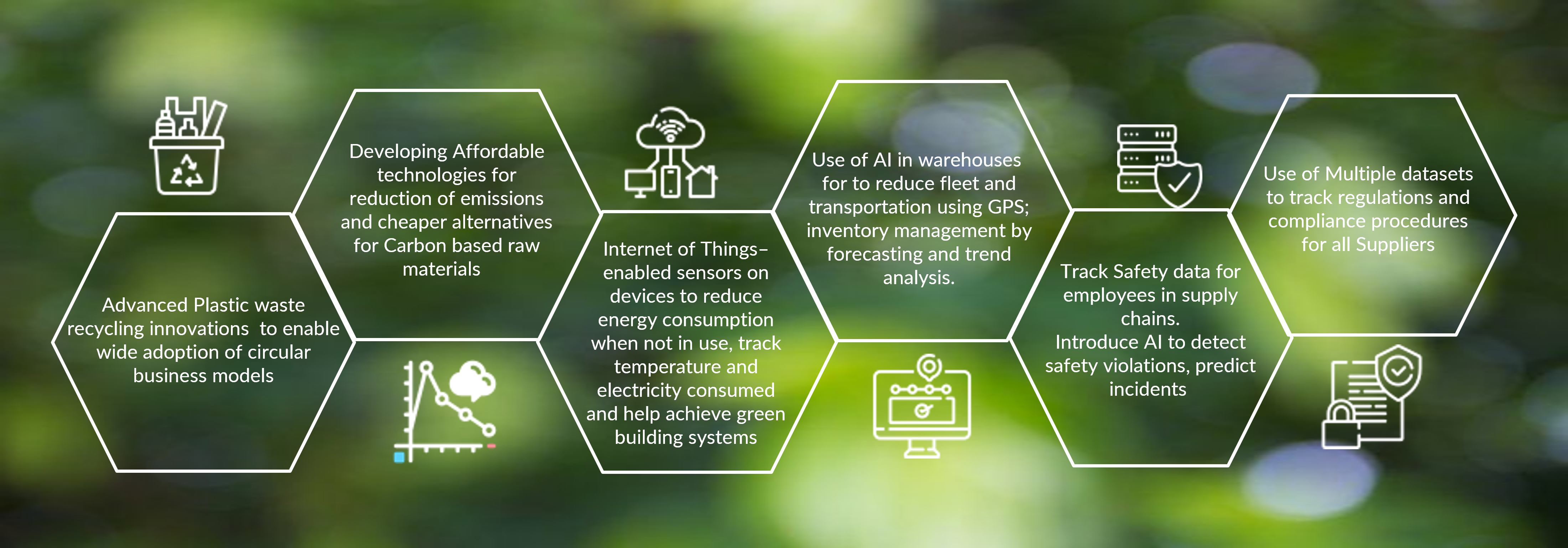The Role of Technology and Innovation in Advancing ESG and Sustainability in Supply Chains
Authored by Akshay Kurian, Product lead, Sustainable Innovation at Treeni Sustainability Solutions28 September, 2023

In today’s dynamic global business environment, ESG has evolved from a trend to a necessity. Collaboration - among enterprises, suppliers, and industries - is the key to realizing ESG goals. To accelerate conversation and collaboration, ESG veterans from various sectors came together to create a dialogue around sustainability in the Sustainability Summit and Awards 2023 (organized by UBS Forums).
This blog is a summary of my talk at the summit.
Sustainability and Supply Chains
As we know, ESG encompasses a trio of factors that evaluate a company's environmental, ethical, and societal impact, representing a shift towards a more holistic and sustainable approach to business. Within supply chains, ESG considerations entail scrutinizing processes and practices to mitigate environmental harm, promote social well-being, and bolster governance standards.
The importance of embracing ESG and sustainability within supply chains cannot be overstated. It serves as a robust mechanism for enhancing transparency and accountability, spotlighting crucial issues like child labor, hazardous working conditions, and scope-3 emissions. By weaving ESG principles into the fabric of supply chain management, companies can demonstrate their commitment to responsible business while cultivating resilience and longevity through transparency.
Supply Chain Transparency
As the name suggests, supply chain transparency refers to the accessibility, accountability, and legitimacy of all the data in a supply chain. Moreover, the data should provide a clear picture to an enterprise about the supply chain’s ESG performance.
Harnessing technology can be a game-changer in achieving this transparency. Leveraging digital tools and platforms can provide enterprises with comprehensive visibility into their suppliers, processes, and product origins.
However, the accountability for a transparent supply chain rests on more than just large enterprises. Small and medium-sized business (SMB) suppliers are also integral to this equation and must play their part. Of course, it’s easier said than done. Let’s look at some challenges enterprises and suppliers face in this journey.
Challenges and Barriers
Fragmented Supply Chains -
The first challenge pertains to the nature of supply chains, which often fall into two broad categories: organized and disorganized. Due to their fragmented structure, disjointed supply chains need help to adopt ESG reporting and technology-driven solutions.Lack of Expertise -
The second challenge comes from the sheer scale of supplier relationships that enterprises manage across diverse industries. This varied nature presents a knowledge gap, as enterprises may need more expertise in specific sectors, hindering their ability to control the scope-3 footprint effectively.Lack of Infrastructure -
Furthermore, many supply chains must be equipped to adopt integrated technology solutions to address the limitations of infrastructure, capital, and knowledge. This poses a considerable challenge in implementing technology-driven sustainability solutions.
Addressing these challenges demands proactive measures. Compliance requirements set forth by regulators and customers demand a focused approach to align supply chain practices with ESG principles. By adopting best practices, organizations can navigate these challenges effectively
Technological Advancements
Technology plays a pivotal role in advancing ESG goals within supply chains. It facilitates the collection, monitoring, and improvement of ESG performance across the entire supply chain ecosystem. Real-time ESG data, in particular, holds immense value, empowering organizations to make informed sustainability decisions promptly.

Adopting technology-driven solutions can streamline processes, reduce emissions, and enhance social and governance standards. It enables supply chain professionals to track and report on ESG metrics accurately, fostering a culture of continuous improvement.
I wrote a blog a few months back about how technology can be leveraged to improve ESG data and reporting.
Practical Implementation
In pursuing ESG excellence within supply chains, Treeni emerges as a valuable partner. During the presentation, we demonstrated how Treeni’s specifically tailored ESG SaaS platforms and specialized managed services can help CSOs, ESG professionals, and Chief Procurement Officers bridge the gap between enterprises and suppliers.
We understand the intricacies of supply chain sustainability and offer tailored solutions to bring transparency to every link in the supply chain. Our comprehensive approach encompasses ESG data management, including collection, analysis, and reporting, which allows enterprises and suppliers to take proactive steps toward overcoming the challenges of fragmented supply chains, lack of infrastructure, and lack of expertise.
Conclusion
During the summit, one thing was clear - the industry consensus towards ESG is stronger than ever. ESG and sustainability are the bedrock of responsible and resilient supply chain management. The journey towards transparency and sustainability may be fraught with challenges, but technology-driven solutions offer a beacon of hope.
With the right strategies and reporting platforms - like Treeni’s resustain™ SMB and resustain™ Enterprise - supply chain professionals can chart a course toward a more sustainable and prosperous future that harmonizes business success with social and environmental responsibility.
__________________________________________________________________________________________________________________________________________________

